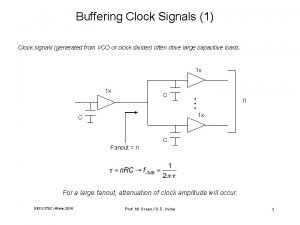Lecture 19 Packaging Power Clock Outline q Packaging































- Slides: 31

Lecture 19: Packaging, Power, & Clock

Outline q Packaging q Power Distribution q Clock Distribution 21: Package, Power, and Clock CMOS VLSI Design 4 th Ed. 2

Packages q Package functions – Electrical connection of signals and power from chip to board – Little delay or distortion – Mechanical connection of chip to board – Removes heat produced on chip – Protects chip from mechanical damage – Compatible with thermal expansion – Inexpensive to manufacture and test 21: Package, Power, and Clock CMOS VLSI Design 4 th Ed. 3

Package Types q Through-hole vs. surface mount 21: Package, Power, and Clock CMOS VLSI Design 4 th Ed. 4

Chip-to-Package Bonding q Traditionally, chip is surrounded by pad frame – Metal pads on 100 – 200 mm pitch – Gold bond wires attach pads to package – Lead frame distributes signals in package – Metal heat spreader helps with cooling 21: Package, Power, and Clock CMOS VLSI Design 4 th Ed. 5

Advanced Packages q Bond wires contribute parasitic inductance q Fancy packages have many signal, power layers – Like tiny printed circuit boards q Flip-chip places connections across surface of die rather than around periphery – Top level metal pads covered with solder balls – Chip flips upside down – Carefully aligned to package (done blind!) – Heated to melt balls – Also called C 4 (Controlled Collapse Chip Connection) 21: Package, Power, and Clock CMOS VLSI Design 4 th Ed. 6

Package Parasitics q Use many VDD, GND in parallel – Inductance, IDD 21: Package, Power, and Clock CMOS VLSI Design 4 th Ed. 7

Heat Dissipation q 60 W light bulb has surface area of 120 cm 2 q Itanium 2 die dissipates 130 W over 4 cm 2 – Chips have enormous power densities – Cooling is a serious challenge q Package spreads heat to larger surface area – Heat sinks may increase surface area further – Fans increase airflow rate over surface area – Liquid cooling used in extreme cases ($$$) 21: Package, Power, and Clock CMOS VLSI Design 4 th Ed. 8

Thermal Resistance q ΔT = Θja. P – ΔT: temperature rise on chip – Θja: thermal resistance of chip junction to ambient – P: power dissipation on chip q Thermal resistances combine like resistors – Series and parallel q Θja = Θjp + Θpa – Series combination 21: Package, Power, and Clock CMOS VLSI Design 4 th Ed. 9

Example q Your chip has a heat sink with a thermal resistance to the package of 4. 0° C/W. q The resistance from chip to package is 1° C/W. q The system box ambient temperature may reach 55° C. q The chip temperature must not exceed 100° C. q What is the maximum chip power dissipation? q (100 -55 C) / (4 + 1 C/W) = 9 W 21: Package, Power, and Clock CMOS VLSI Design 4 th Ed. 10

Temperature Sensor q Monitor die temperature and throttle performance if it gets too hot q Use a pair of pnp bipolar transistors – Vertical pnp available in CMOS q Voltage difference is proportional to absolute temp – Measure with on-chip A/D converter 21: Package, Power, and Clock CMOS VLSI Design 4 th Ed. 11

Power Distribution q Power Distribution Network functions – Carry current from pads to transistors on chip – Maintain stable voltage with low noise – Provide average and peak power demands – Provide current return paths for signals – Avoid electromigration & self-heating wearout – Consume little chip area and wire – Easy to lay out 21: Package, Power, and Clock CMOS VLSI Design 4 th Ed. 12

Power Requirements q VDD = VDDnominal – Vdroop q Want Vdroop < +/- 10% of VDD q Sources of Vdroop – IR drops – L di/dt noise q IDD changes on many time scales 21: Package, Power, and Clock CMOS VLSI Design 4 th Ed. 13

IR Drop q A chip draws 24 W from a 1. 2 V supply. The power supply impedance is 5 mΩ. What is the IR drop? q IDD = 24 W / 1. 2 V = 20 A q IR drop = (20 A)(5 mΩ) = 100 m. V 21: Package, Power, and Clock CMOS VLSI Design 4 th Ed. 14

L di/dt Noise q A 1. 2 V chip switches from an idle mode consuming 5 W to a full-power mode consuming 53 W. The transition takes 10 clock cycles at 1 GHz. The supply inductance is 0. 1 n. H. What is the L di/dt droop? q ΔI = (53 W – 5 W)/(1. 2 V) = 40 A q Δt = 10 cycles * (1 ns / cycle) = 10 ns q L di/dt droop = (0. 1 n. H) * (40 A / 10 ns) = 0. 4 V 21: Package, Power, and Clock CMOS VLSI Design 4 th Ed. 15

Bypass Capacitors q Need low supply impedance at all frequencies q Ideal capacitors have impedance decreasing with w q Real capacitors have parasitic R and L – Leads to resonant frequency of capacitor 21: Package, Power, and Clock CMOS VLSI Design 4 th Ed. 16

Power System Model q Power comes from regulator on system board – Board and package add parasitic R and L – Bypass capacitors help stabilize supply voltage – But capacitors also have parasitic R and L q Simulate system for time and frequency responses 21: Package, Power, and Clock CMOS VLSI Design 4 th Ed. 17

Frequency Response q Multiple capacitors in parallel – Large capacitor near regulator has low impedance at low frequencies – But also has a low self-resonant frequency – Small capacitors near chip and on chip have low impedance at high frequencies q Choose caps to get low impedance at all frequencies 21: Package, Power, and Clock CMOS VLSI Design 4 th Ed. 18

Example: Pentium 4 q Power supply impedance for Pentium 4 – Spike near 100 MHz caused by package L q Step response to sudden supply current chain – 1 st droop: on-chip bypass caps – 2 nd droop: package capacitance – 3 rd droop: board capacitance [Xu 08] 21: Package, Power, and Clock CMOS VLSI Design 4 th Ed. [Wong 06] 19

Charge Pumps q Sometimes a different supply voltage is needed but little current is required – 20 V for Flash memory programming – Negative body bias for leakage control during sleep q Generate the voltage on-chip with a charge pump 21: Package, Power, and Clock CMOS VLSI Design 4 th Ed. 20

Energy Scavenging q Ultra-low power systems can scavenge their energy from the environment rather than needing batteries – Solar calculator (solar cells) – RFID tags (antenna) – Tire pressure monitors powered by vibrational energy of tires (piezoelectric generator) q Thin film microbatteries deposited on the chip can store energy for times of peak demand 21: Package, Power, and Clock CMOS VLSI Design 4 th Ed. 21

Clock Distribution q On a small chip, the clock distribution network is just a wire – And possibly an inverter for clkb q On practical chips, the RC delay of the wire resistance and gate load is very long – Variations in this delay cause clock to get to different elements at different times – This is called clock skew q Most chips use repeaters to buffer the clock and equalize the delay – Reduces but doesn’t eliminate skew 21: Package, Power, and Clock CMOS VLSI Design 4 th Ed. 22

Example q Skew comes from differences in gate and wire delay – With right buffer sizing, clk 1 and clk 2 could ideally arrive at the same time. – But power supply noise changes buffer delays – clk 2 and clk 3 will always see RC skew 21: Package, Power, and Clock CMOS VLSI Design 4 th Ed. 23

Review: Skew Impact q Ideally full cycle is available for work q Skew adds sequencing overhead q Increases hold time too 21: Package, Power, and Clock CMOS VLSI Design 4 th Ed. 24

Solutions q Reduce clock skew – Careful clock distribution network design – Plenty of metal wiring resources q Analyze clock skew – Only budget actual, not worst case skews – Local vs. global skew budgets q Tolerate clock skew – Choose circuit structures insensitive to skew 21: Package, Power, and Clock CMOS VLSI Design 4 th Ed. 25

Clock Dist. Networks q q Ad hoc Grids H-tree Hybrid 21: Package, Power, and Clock CMOS VLSI Design 4 th Ed. 26

Clock Grids q q Use grid on two or more levels to carry clock Make wires wide to reduce RC delay Ensures low skew between nearby points But possibly large skew across die 21: Package, Power, and Clock CMOS VLSI Design 4 th Ed. 27

Alpha Clock Grids 21: Package, Power, and Clock CMOS VLSI Design 4 th Ed. 28

H-Trees q Fractal structure – Gets clock arbitrarily close to any point – Matched delay along all paths q Delay variations cause skew q A and B might see big skew 21: Package, Power, and Clock CMOS VLSI Design 4 th Ed. 29

Itanium 2 H-Tree q Four levels of buffering: – Primary driver – Repeater – Second-level clock buffer – Gater q Route around obstructions 21: Package, Power, and Clock CMOS VLSI Design 4 th Ed. 30

Hybrid Networks q Use H-tree to distribute clock to many points q Tie these points together with a grid q Ex: IBM Power 4, Power. PC – H-tree drives 16 -64 sector buffers – Buffers drive total of 1024 points – All points shorted together with grid 21: Package, Power, and Clock CMOS VLSI Design 4 th Ed. 31
 Fast clock to slow clock synchronization
Fast clock to slow clock synchronization What is 1 hour
What is 1 hour Brc global standards directory
Brc global standards directory Steve tattum
Steve tattum 01:640:244 lecture notes - lecture 15: plat, idah, farad
01:640:244 lecture notes - lecture 15: plat, idah, farad Power triangle diagram
Power triangle diagram Lecture outline example
Lecture outline example Lecture outline example
Lecture outline example Lecture outline example
Lecture outline example Lecture outline meaning
Lecture outline meaning Routing in physical design
Routing in physical design Sandwich sentences
Sandwich sentences Power system dynamics and stability lecture notes
Power system dynamics and stability lecture notes Zline 667-36
Zline 667-36 Power semiconductor devices lecture notes
Power semiconductor devices lecture notes Switch mode power supply lecture notes
Switch mode power supply lecture notes Power system dynamics and stability lecture notes
Power system dynamics and stability lecture notes Solar power satellites and microwave power transmission
Solar power satellites and microwave power transmission Potential power
Potential power Flex28024a
Flex28024a Dispersive power of a grating is defined as
Dispersive power of a grating is defined as Power of a power property
Power of a power property General power rule vs power rule
General power rule vs power rule Power angle curve in power system stability
Power angle curve in power system stability Power bi power point
Power bi power point Power delivered vs power absorbed
Power delivered vs power absorbed Roman clock
Roman clock What is a quarter past 8
What is a quarter past 8 Its 12 o clock
Its 12 o clock Half past participle
Half past participle Transformation of energy of wall clock
Transformation of energy of wall clock 24 hour format clock
24 hour format clock























































